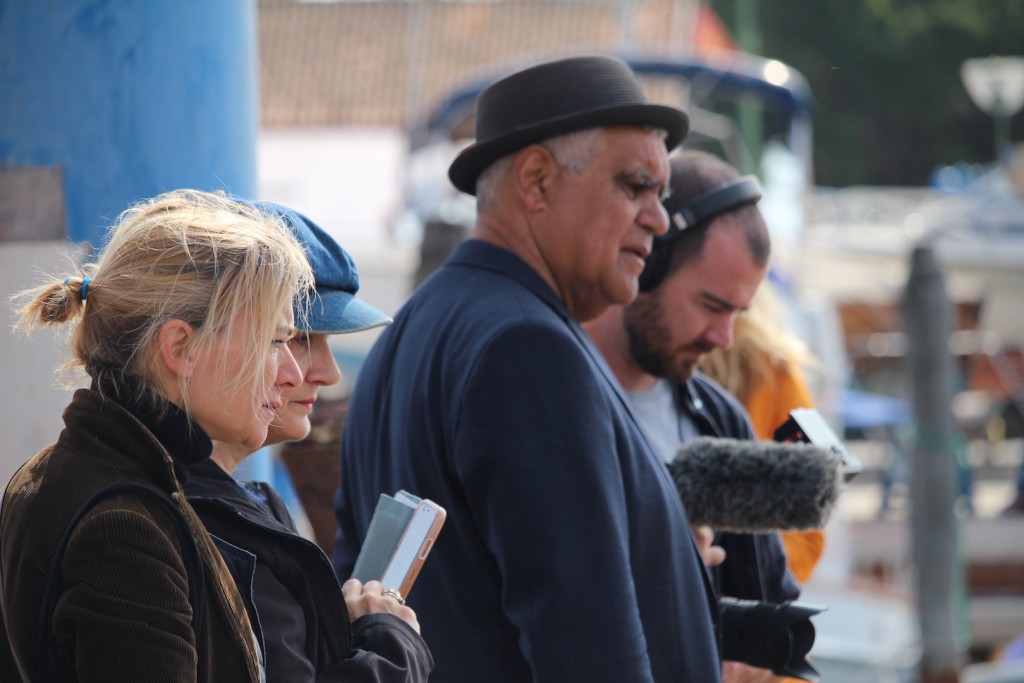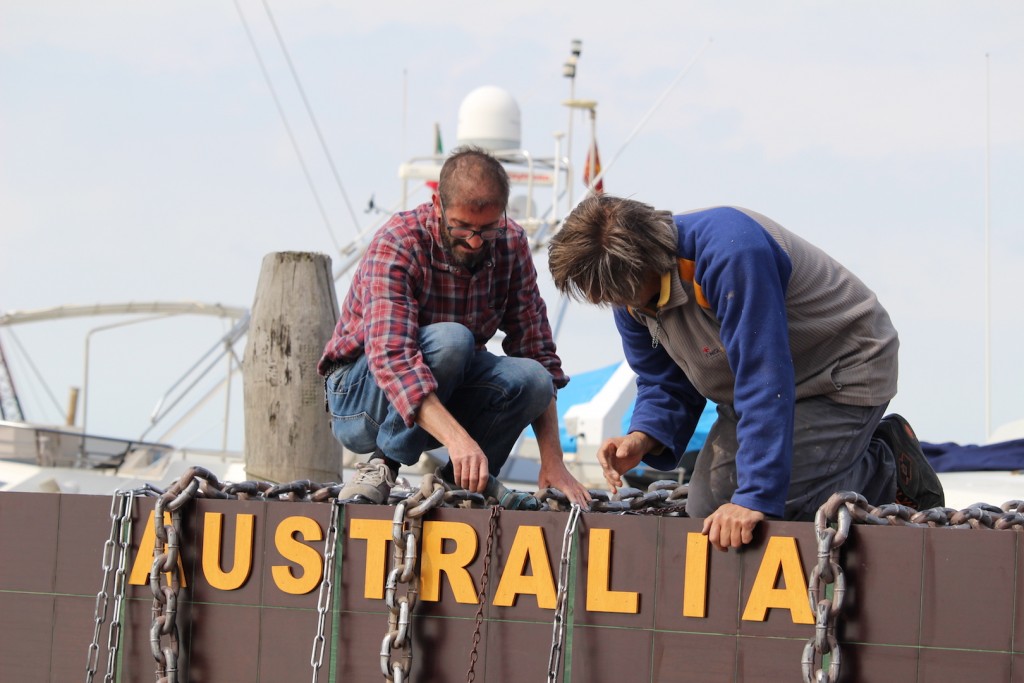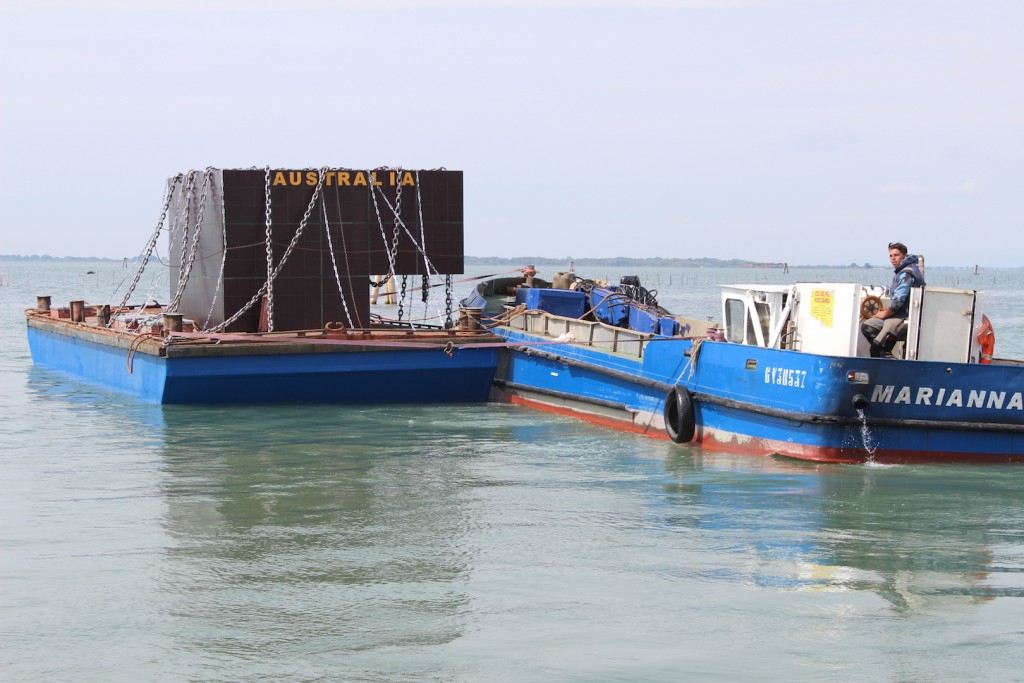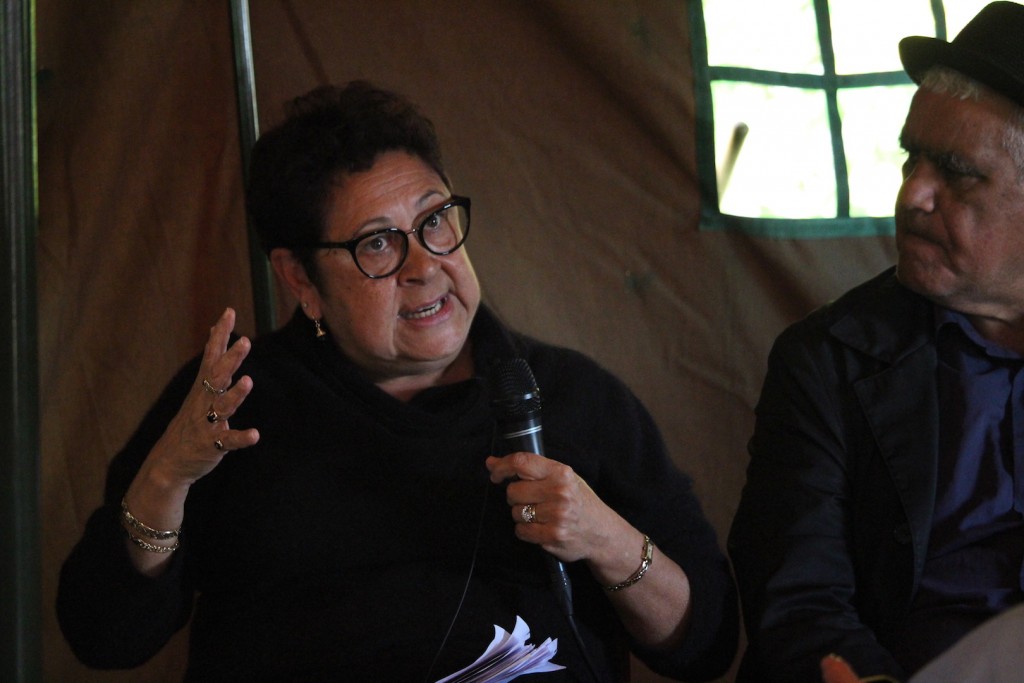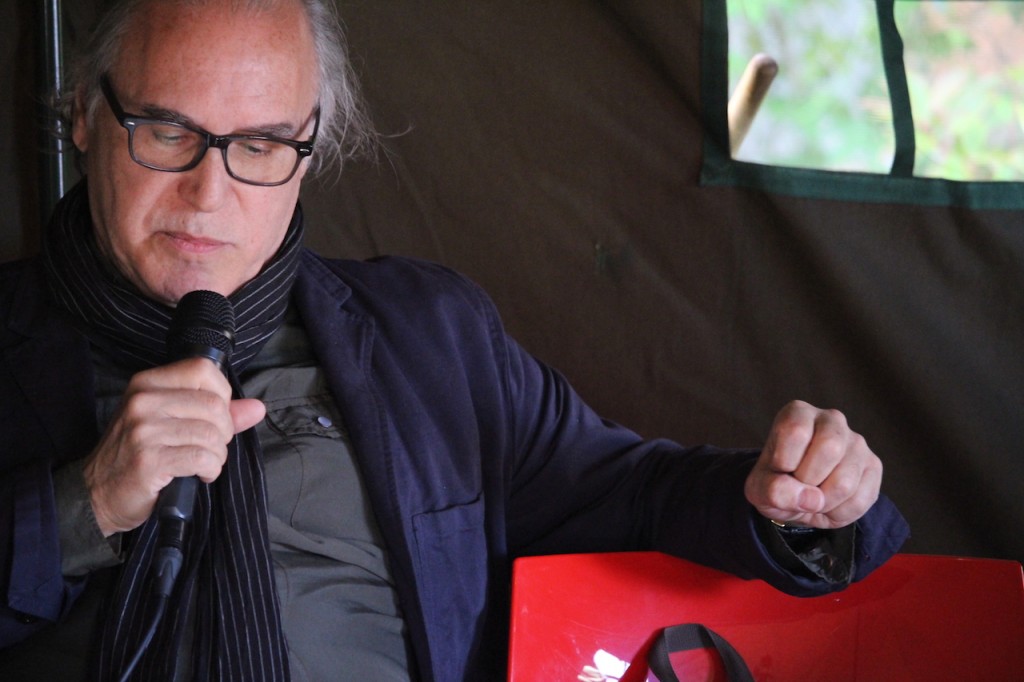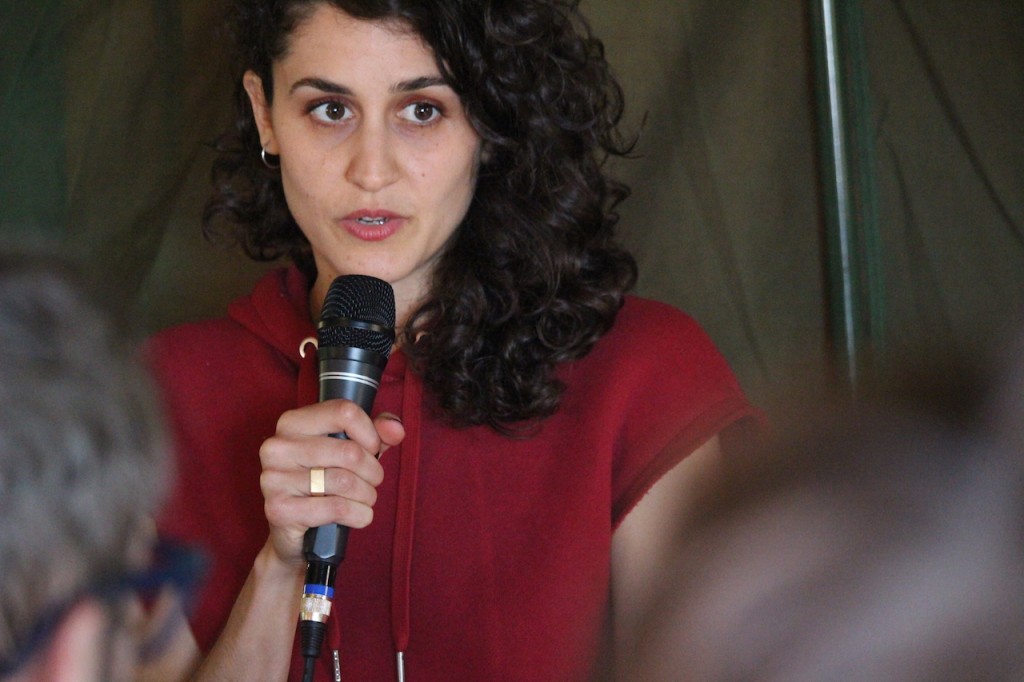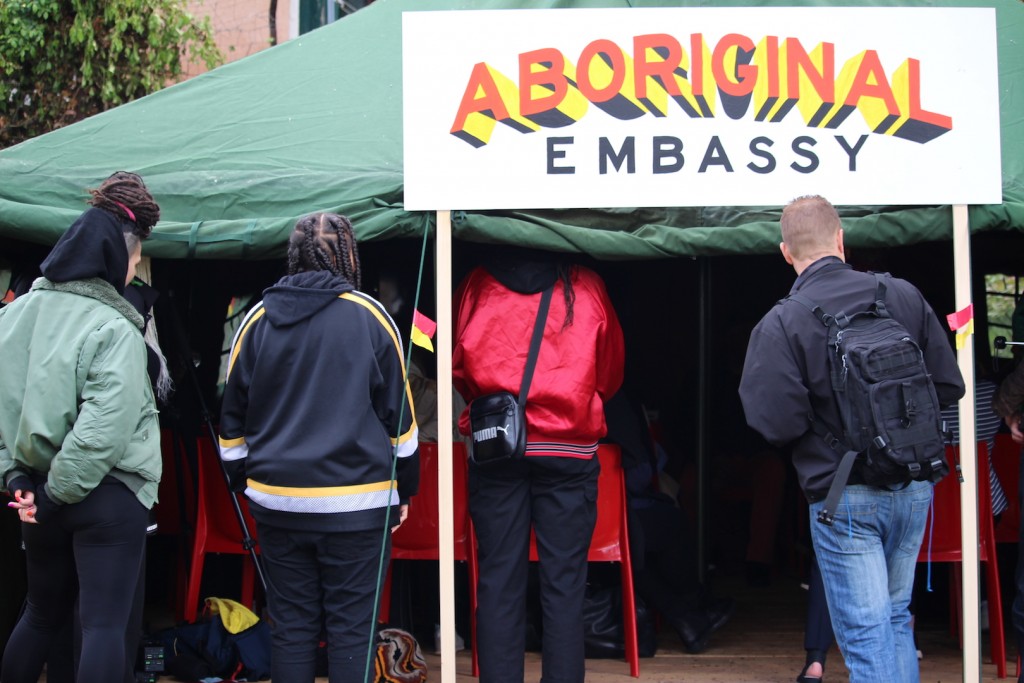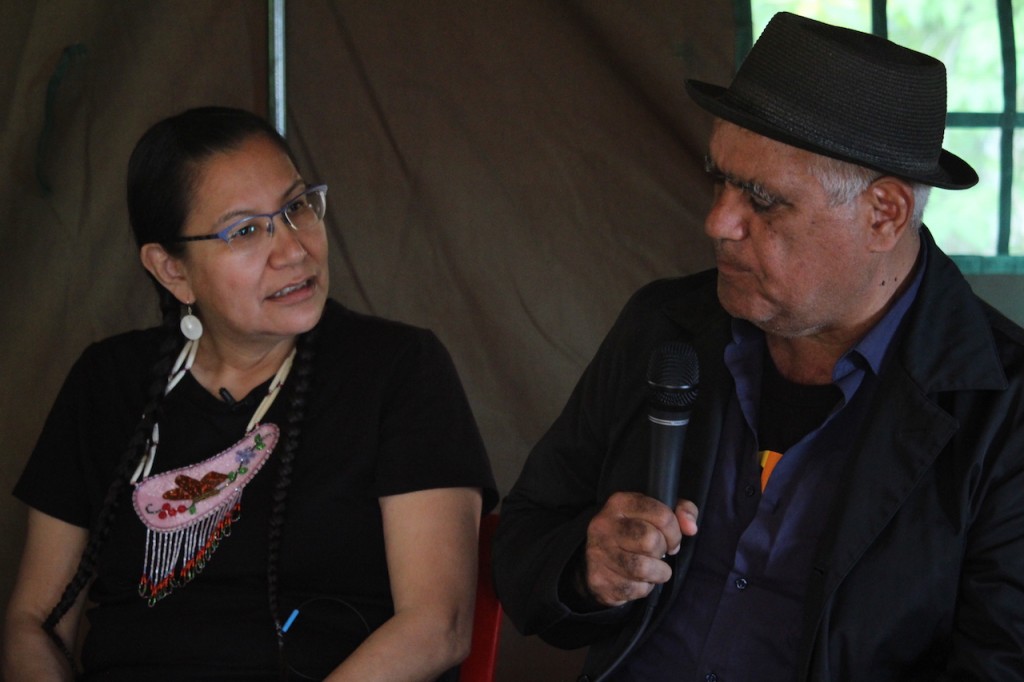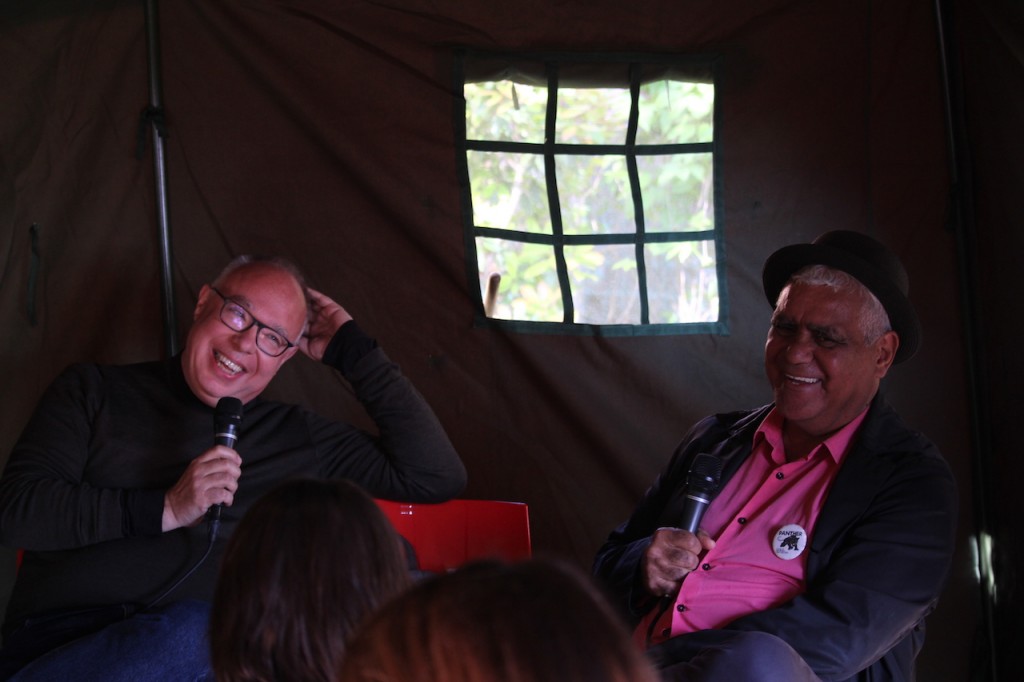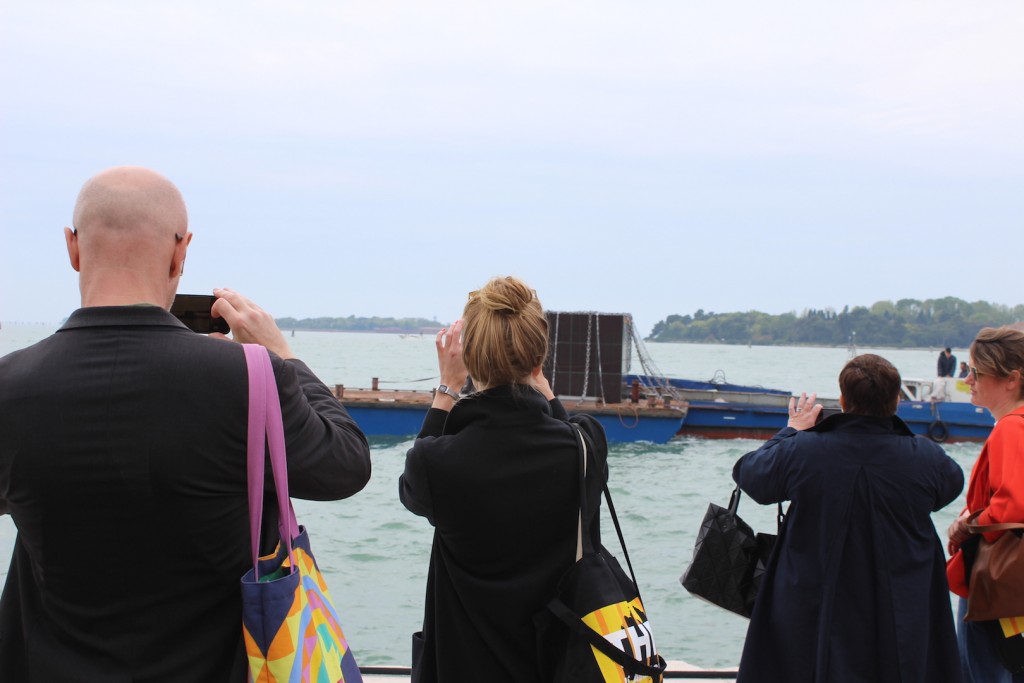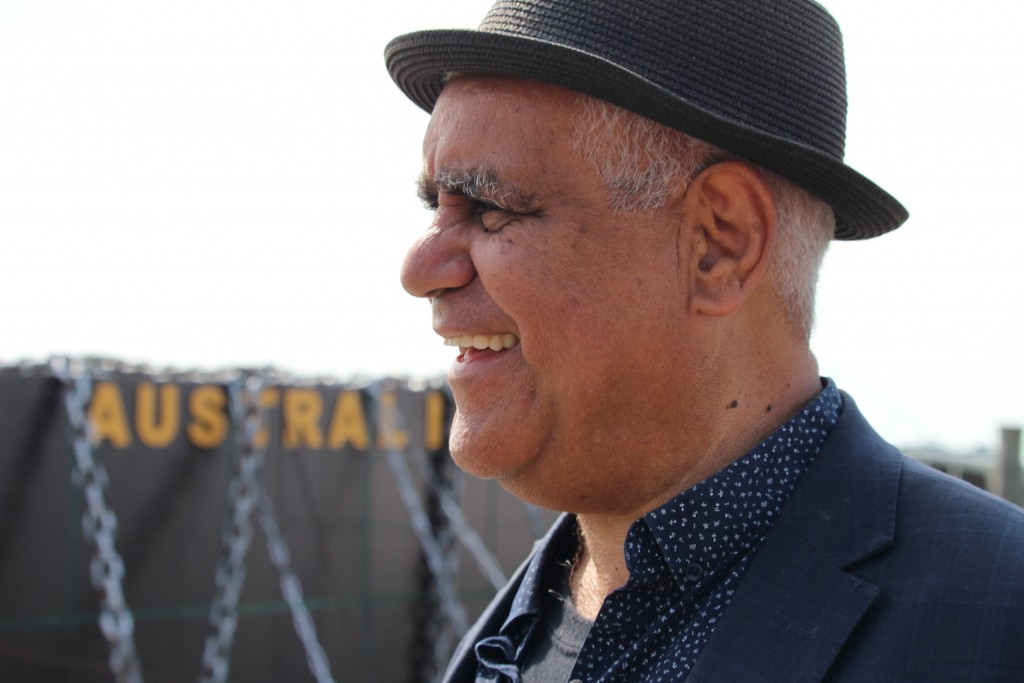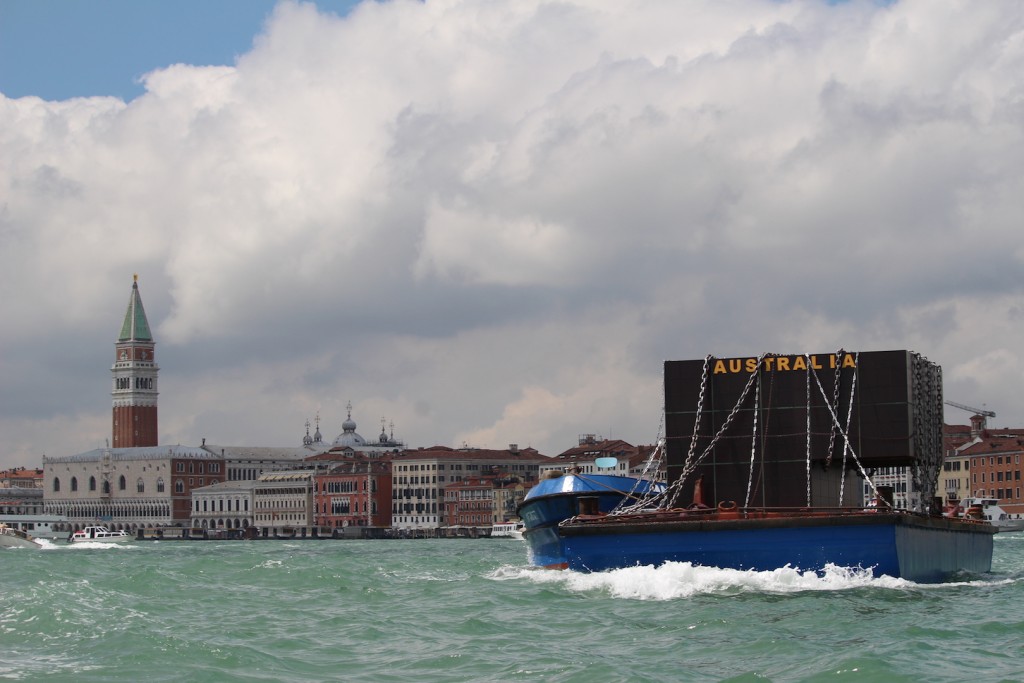Saturday 12 May 2019
Compagnia della Vela, Isola di San Giorgio, Venice
Rapper JessWAR prowls a low stage. Aflame under red lights, her audience is primed following the lyrical stylings of Jess’s Fempress comrades. The night outside is chilly, but on this dancefloor, they’re sweating. “I want to see all you beautiful black women up the front!” Jess commands, before leaping up, shouting “I’M A SAVAGE…”
Friday 10 May 2019
Giardini Marinaressa
Quandamooka artist Megan Cope is being interviewed beside the Venetian lagoon.
“We’re used to this,” she says. “We’re used to having to go to these lengths, to make guerrilla style artwork – to actually force our way in, in lots of ways … It is our turn to be listened to now. The system, all of the things that were used to justify our dispossession, our culture, and our way of life is revealing itself to be a catastrophic failure. So it is time to listen to first people globally. It’s just time.”
Thursday 9 May 2019
Giardini Marinaressa
Archaeologist Liisa – Ravna Finborg stands outside a large canvas tent, following an emotional conversation shared inside with her peers in the Sámi artistic community. “We are still here. You can try and kill us, you can try and kill our culture, you can try and take our knowledge, but man, we are resilient as a people. And that is what Richard’s Embassy is all about. Resiliance.”
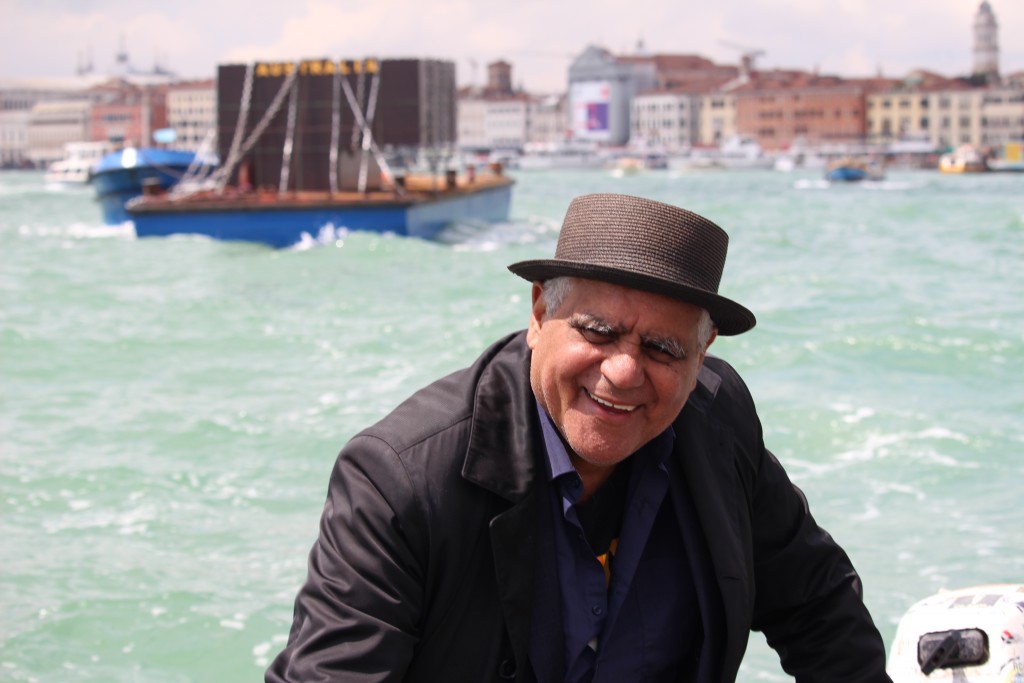
Being turned down to represent Australia at this year’s Venice Biennale happened to be the ideal outcome for artist Richard Bell’s project EMBASSY2019: Venice.
Growing outside of the Biennale gardens, liberated from official sanction, Bell’s artwork rose autonomously to create a new, cheeky happening – arguably his most “Richard Bell”-like caper yet – alongside a new space for the ongoing work EMBASSY, in which Bell hosts international conversations with Indigenous speakers.
Shortlisted to represent Australia in this year’s Venice Biennale, Richard Bell’s proposed work, “We don’t really need this” sought to wrap the Australian pavilion – that “big black box for white art” – in chains.
The pavilion itself would become a monumental outdoor sculpture. Bell planned to “effectively lock audiences out of the building in a symbolic gesture against not only the full scale invasion of the arts by capitalist colonialist forces, but more importantly as an insistent Aboriginal refusal of the white space that symbolises the ongoing dispossession and dehumanisation of Indigenous peoples.”
Beside this, Bell’s well-travelled work EMBASSY would be erected, so that conversation about matters outside the elitist confines of the Biennale could ensue. EMBASSY, an ongoing work since 2013 that is both inspired by and homage to the original Aboriginal Tent Embassy, has been exhibited across the world and has recently been acquired by the TATE for exhibition in 2021.
It was a bold plan, and when unsuccessful, disappointing for Richard and his curator Clothilde Bullen – this would have been the first time a single Aboriginal artist would be curated by a single Aboriginal curator for the Venice Biennale.
Never one to ask for permission, Richard Bell went ahead and did it anyway. And in doing so, he imbued these artworks with a deeper power that resonated with audience and participants, as well as creating an artistic process that enveloped the artwork in ongoing digital expansion.
I work as co-producer of media entity POPSART alongside “rapporteur” and co-producer Bec Mac. Last year, as part of POPSART’s artistic residency in Brisbane cooperative space, WECOWORK, Bec Mac invited Richard Bell to speak at one of her monthly salons.
Like many of Richard’s allies, Bec knew of the Venice proposal and was disappointed with the official outcome. She asked Richard to speak about his proposal in the hope that the spark may somehow remain lit. This salon energised a grassroots funding campaign. Over ten months from July 2018, through private, organizational, and crowd-funding – and particularly, the artist’s self funding alongside the support of Brisbane’s Milani Gallery – the project became increasingly feasible. T-shirts were printed, then re-printed, and tote bags flogged. As part of the campaign, POPSART collaborated with Richard on a series of digital media works, which are now enmeshed with the EMBASSY2019 suite of work. Recently, these works (with themes such as “Surrender your power to yourself” and “Be my ally: let’s talk about it”) were shown as part of the “OK Democracy, we need to talk” exhibition at Campelltown Arts Centre.
Later, donor organisations such as Australia Council and Arts Queensland provided financial support, but it is interesting to note that the initial financial backbone of Richard Bell’s EMBASSY2019: Venice project was a crowdfunding website. For this democratic work, apt.
Through the assistance of Bell’s long-term friend and anthropological academic, Franca Tamisari, Bell landed a gun Venetian team to make this concept a reality, and travelled frequently to Venice to oversee the project.
Now titled “… no tin shack …”, Bell’s new work was built as a scale model of the Australian pavillion and launched the morning of Wednesday 8 May at the Crea shipyard, Giudecca. The build took place on the island of Giudecca, where many of Bell’s team reside.
“It’s all happening on the Giudecca, which is one of the remaining (Venetian) enclaves where the societal fabric is still quite intact,” explained architect Lorenzo Pesola. As he watched the structure lowered by crane onto a large barge, Pesola stressed the amiable nature of the project: “I’ve been thinking about this moment for the past 40 days… we’ve been lucky enough to be able to do this job with friends, friends who are sympathetic from the very beginning … when Richard arrived, it was just another friend who came into our work flow.“
The morning of the launch, the weather in Venice was gorgeous, the mood glorious. Richard Bell’s international team, which he frequently credits as collaborators in his work, are a dedicated mob. We are all heart-first invested in Richard himself as much as this work.
Over the morning, the pavillion structure was locked onto the barge, its roof secured, and chains set in place. Prosecco was liberally poured, and “… no tin shack…” set sail in an emotional start to what would be a rather joyful, emotional week.
As “…no tin shack…” traversed the lagoon, spraying questions of elitism and the impact of colonisation in its wake, Bell’s ongoing work EMBASSY looked out from the land, seeking to address these questions in a series of conversations with key figures within first nations communities.
To secure its venue, EMBASSY was exhibited as part of the European Cultural Centre’s Personal Structures exhibition, in a superb location – a park set between the two Biennale hubs, Arsenale and the Giardini. Perched at the back of the Giardini Marinaressa, EMBASSY’s physical presence was defined by a large canvas tent flagged by Bell’s painted signage. (Earlier incarnations have used different sized tents, or deck chairs and beach umbrellas, referencing the earliest incarnation of the Aboriginal Tent Embassy.) Inside, chairs and a little AV equipment were all geared for conversation. Outside the tent, visitors could gaze across the Venetian lagoon. Between the vulgarity of docked superyachts, “…no tin shack…” occasionally chugged into sight as it sailed its rounds of the lagoon.
Inside the khaki tent, guests included Quandamooka artist Megan Cope, international curator Professor Charles Esche, American-born, Berlin-based Palestinian artist Jumana Manna, nêhiyaw “Idle No More” activist Sylvia McAdam (Saysewahum), New York Mohawk artist Alan Michelson, distinguished ProfessorAileen Moreton Robinson, anthropologist Michael Taussig and Franca Tamisari. As documentation collaborators, POPSART recorded Bec Mac’s interviews with participants following their sessions, adding artistic layers in medium and time.
The week before EMBASSY2019’s planned launch, leaders of the Sámi parliament of northern Europe contacted Richard, who invited their artistic representatives to participate. This conversation launched EMBASSY on Thursday 9 May, with a sombre education on the Sámi experience of maintaining artistic and cultural relevance, of existing as indigenous people in northern Europe.
Artist Fredrik Prost creates traditional handicrafts using the tools and materials of his ancestors. His ancestors faced death for making the drums that Prost now creates.
“The drums were forbidden. The burned both our drums and our shamen at the stake.” Prost explained. “If we’re taking that back, our spirituality, our drums, then we’re taking back part of our self confidence and sense of ourselves as a people.”
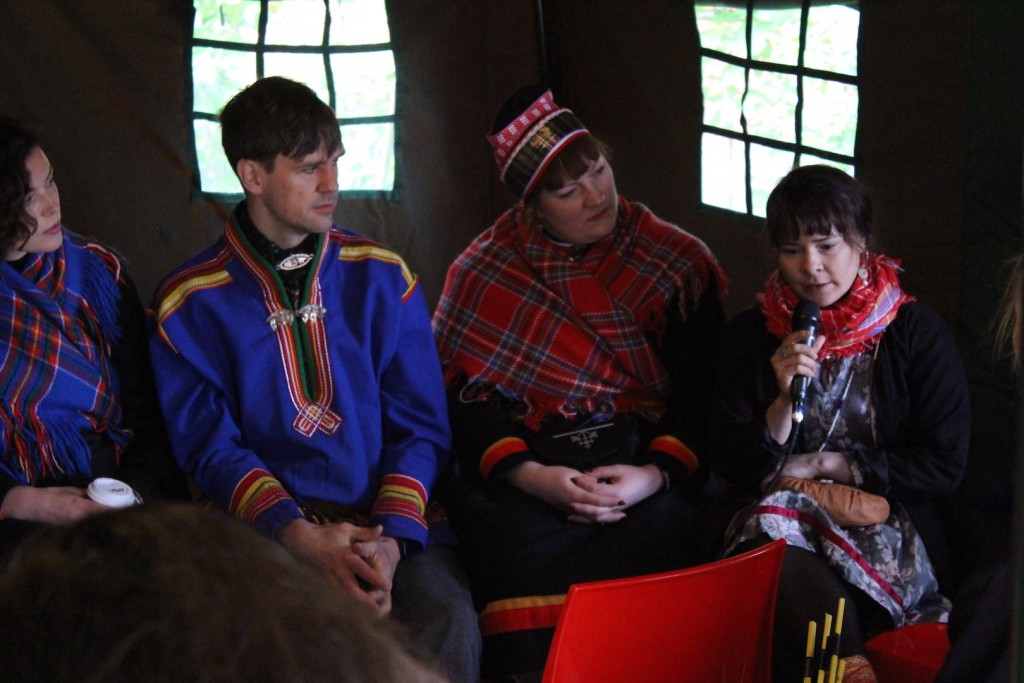 In an interview following EMBASSY, Sámi artist and reindeer keeper Inga Wiktoria Påve flagged how maintaining an aesthetic distinction between indigenous handicrafts and western concepts of high art has kept aboriginal cultures from participating equally in institutions. And it’s not as simple as “art versus craft” school fete dilemmas.
In an interview following EMBASSY, Sámi artist and reindeer keeper Inga Wiktoria Påve flagged how maintaining an aesthetic distinction between indigenous handicrafts and western concepts of high art has kept aboriginal cultures from participating equally in institutions. And it’s not as simple as “art versus craft” school fete dilemmas.
“In the Sámi world both art and handicraft are so tightly connected to each other … it’s not just ‘crafts’, a lot of these things are connected with our history and all the markings have a history and the things that we do tell a story. It’s kind of the story of us, it’s also the story of our history,” she explained.
“Sometimes it actually feels like just being a Sámi and showing off your handicraft or doudji or your art, it’s a political statement just being ‘you’.”
Richard Bell’s EMBASSY, camped in a garden beyond the antediluvian national pavilions, waltzed fresh conversations into a weary Venetian salon. Speakers embraced this space, conversations flowed, and the very air felt energised with hope. EMBASSY provided symbolic global indigenous immunity. It felt anti-national. It felt good.
Idle No More founder and member of the Canadian Cree Nation Sylvia Macadam Saysewahum fights to save her family’s traditional land. She doesn’t call herself an environmentalist (“If someone was breaking into your home, no one would describe you as an environmentalist, and this is my home, these are my homelands,” she says). Silence is construed as consent. Macadam chooses to not be silent.
Spaces like EMBASSY, Macadam says, “are powerful, and they amplify the messages of indigenous people’s voices, and they’re so needed.”
To Inga Wiktoria Påve, “(EMBASSY) felt like a safe space to be amongst other Aboriginal people talking about our issues … to get our issues out to other people who are not indigenous to understand our point of view on our situation, both political and art situation.” Her colleague Liisa-Rayna Einborg noted how, in a Biennale where the Sámi’s official invitation felt like an officially sanctioned inclusion, Richard Bell went ahead and created his artwork without asking for anyone’s permission. (In fact, this is the title of one of Bell’s earliest videos with POPSART, “Don’t ask for permission”.) The “symbolic effect of Richard making and reclaiming space outside of that official sanction” strengthened her resolve and her identity, she says.
The Sámi artists returned – along with an increasing number of Indigenous and non-indigenous artists, curators, academics, and supporters – to EMBASSY frequently over the week of its Venetian incarnation. As an audience member mentioned after one of the week’s sessions, EMBASSY creates a version of Aboriginal land (Richard Bell’s version?) wherever it sits. A space for dialogue and contemplation. It is also a concept that is continually referencing, and honouring, the original Aboriginal Tent Embassy that inspired it.
Richard Bell often describes himself as an “activist masquerading as an artist”. Is EMBASSY activism masquerading as artwork? It’s certainly a contemporary contrast to the Biennale around it.
Bell’s guest Charles Esche, director of Eindhoven’s Van Abbemuseum and a radical examiner of the limits of contemporary museums, thinks it’s time to “displace Picasso from his throne … to make it a plural story about the whole of the world and not just about Western Europe and North America.”
Esche says the time for national pavilions is past. “The model of the Venice Biennale, from the nineteenth century, is based on national pavilions, which is a completely out-dated form of how you’d want to talk about culture. If we want to talk about the climate emergency, if we want to talk about indigeneity, the last thing you want to do is get stuck in your little pavilions … it’s very old fashioned.”
“Culture is meant to be something that’s innovative, something that’s creating new ideas, and to do it within a national framework … doesn’t really allow any innovation.”
“Kandinsky and Picasso? There’s nothing more to say. They’re used up. They’re finished.”
The EMBASSY program ended on Saturday afternoon, and was celebrated with a wrap party for the not-just-art-history books. We arrived like rock stars in a water taxi, Richard standing majestically at the back. The work “…no tin shack…” was moored beside the venue, the Venetian Sailing Club – a witty little juxtaposition from Richard’s Italian team. The evening’s performers, Fempress, a new generation of Indigenous awesome, spent a large part of the week inside EMBASSY listening, but this night was their turn to speak up.
After the party, EMBASSY was dismantled and “…no tin shack…” taken off the barge and sited in its place at Marinaressa, where it will remain for the duration of the Venice Biennale (until 24 November 2019). Richard’s team dissolved back to our separate other realities. Bell remains mobile, returning to Europe for a speaking engagement in Amsterdam a week after his Australian return. He will revisit Venice at the Biennale’s end, a scaled-down EMBASSY in tow, to discuss matters Venetian alongside Franca. And all eyes now turn to the TATE for its version of EMBASSY in 2021.
Richard Bell is satisfied. “We put on a fantastic show,” he says, uncharacteristically low-key. “I’m so happy. I couldn’t have imagined a better outcome.”
Richard’s friend and fellow artist Megan Cope is less restrained.
“Never in my wildest dreams did I think I would be invited to come and speak in the tent embassy in Venice. It’s extraordinary. It’s incredible,” she said. “He’s making black history.”
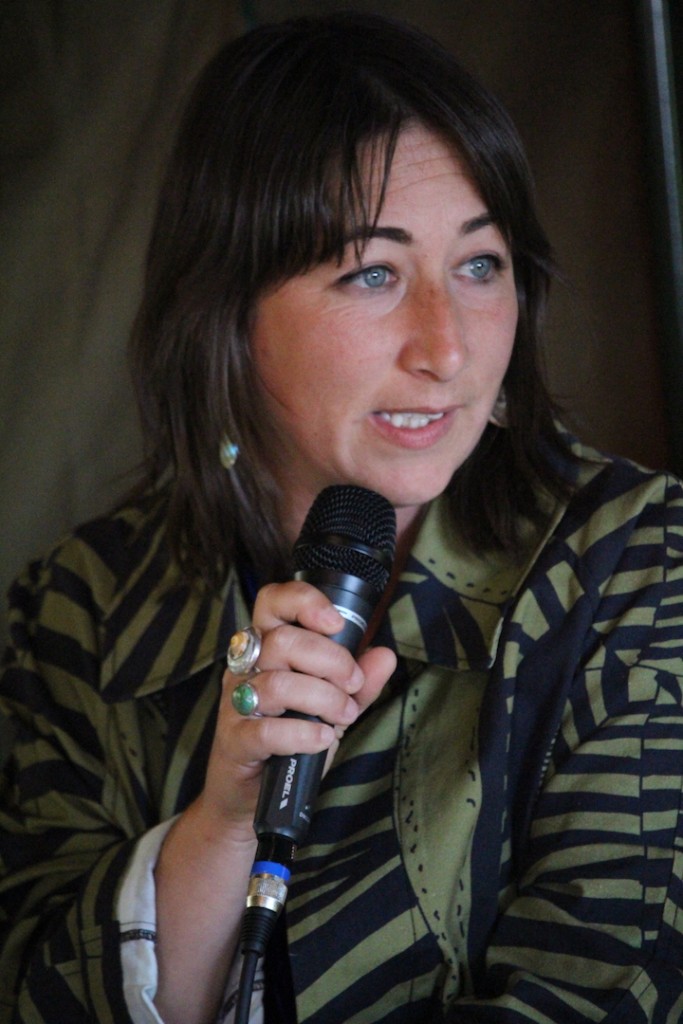
During EMBASSY2019, gallerist Josh Milani noted that creating this work “without the sanctioned confines of the Australia Council is better for Richard because he’s doing it on his terms,” adding, “Our venue is actually better than the Australian pavilion.”
It was certainly freer, and enjoyed growing notoriety while ensconced in the Giardini Marinaressa. But popularity alone does not change coloniser customs.
In between sessions one day, we took a boat into the lagoon to film and photograph “… no tin shack …” as it sailed. When we tried to secure a water taxi for the job, none were interested. Our Italian connections yielded a boat with a radically-inclined driver. We followed the barge as it passed the canal on which the actual Australian pavilion sits, seeking an ironic money shot with this artwork passing its “muse”.
The barge itself is too large to enter this canal, but our little craft was not, and we motored up the canal to get a closer perspective on the Australian pavilion. As we filmed Richard in front of the pavilion, we noticed a photographer we’d tried to connect with earlier and called to him to join us.
So the photographer could alight, our driver moved the boat towards the canal’s edge immediately in front of the Australia pavilion. As we approached to make land, an Italian police officer yelled, rushing to stop us. Richard was standing at the bow.
We watched as the sharply uniformed carabinieri denied access to one of Australia’s leading contemporary artists – and of course, to an Aboriginal man – to the Australian Pavillion at the Venice Biennale.
Richard nodded to the driver, and we backed off.
An edited version of this piece was published in Overland Literary Magazine.
Photographs: Caroline Gardam. All rights reserved.
